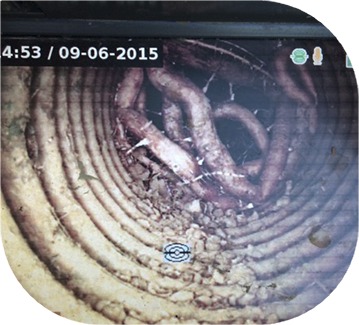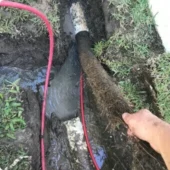What to do about a Blocked sink
These can be caused locally by hair and gunk stuck around the plug hole and pipework leading from the sink into the main household drainage system. Pop up plugs are the biggest culprit of this problem as they can be tricky to get out to clean. The usual scenario to clear a blockage local to a sink/basin is to first plunge to see if this pushes anything within the trap and pipework down into the main drainage system. If this doesn’t clear it, the next step is to undo the trap under the sink or basin to see if there are any foreign objects stuck in it. If there are, it’s just a matter of emptying it out, cleaning the trap and reinstalling it. If when the trap is reinstalled water still isn’t getting away then the blockage is usually not local to the sink or basin and needs to be investigated further.

Blocked floor wastes
These are the drains in bathrooms and laundries. If the sink is blocked and won’t clear then the next step is to plunge the floor waste. There are some tell tell signs if the floor waste is blocked other than the sink not draining, a foul odour is also usually present in the room. If the floor waste has been plunged and is still holding water, the next step is usually to pour in an industrial strength drain acid, this is left to sit in the drain for a short while to break down hair and scum inside the pipework then this is flushed away.
The drain acid we use is very different to the supermarket bought version that doesn’t have the strength of chemicals in it to dissolve these build ups. If the drain is still blocked then further investigations are needed as the blockage is likely not local to the floor waste.
Blocked Showers & baths
These are usually caused by a build up of hair and soap scum over time and can often be fixed with a plunge or acid (as per floor wastes above). We recommend brushing your hair before showering to remove as many loose hairs as possible and using a soap free body wash which not only helps the drains but means your shower glass and tiles don’t develop residue as quickly.

Blocked toilets
These are caused by many different things, most commonly though by too much toilet paper and waste being put down the toilet before flushing. Everything gets stuck in the bend of the toilet discharge pipe and can’t move into the main sewer pipework. To avoid this type of blockage always use full flush and minimise the amount of toilet paper used before flushing.
Never flush anything other than toilet paper and human waste down the toilet, not even those “flushable wipes” as they do not break down like toilet paper and therefore can easily catch on irregular pipework inside the main drainage system or can sit within the water pipes as the amount of water needed to move these along is greater than that of the toilet paper. Also never flush makeup wipes, baby wipes or sanitary products down the toilet. These do not break down either and cause many many blockages.
The last thing we recommend is to never use plastic toilet fresheners over the rim as they can accidentally get dislodged and drop into the bowl and get stuck in the bend. The whole toilet often needs to be removed to retrieve these. The majority of minor blockages at toilets can be resolved with a plunge. Our Gold Coast plumbers carry a different sort of plunger than your average household keeps to hand and they work much better and so although customers may have tried to plunge themselves, our plumber’s plungers can quite often shift what theirs could not.
If the toilet won’t clear with a plunge then the issue is likely to be further down the line in the drainage system and needs further investigations.

Blocked kitchen sinks
These have a few extra issues when it comes to blockages worth mentioning. Grease being poured down the sink will overtime narrow the insides of the pipes by lining them with hardened fat deposits (a bit like your arteries after too many cheese burgers!) It’s sometimes possible to plunge the pipework outside the kitchen sink (the overflow relief gully) to get these fat deposits to break away and move down into the main pipework.
If this doesn’t do the trick then the next thing is to get out the high pressure water jetter and a grease release agent to break down and work through the deposits until the drain is clear.
One other very common cause of blockages at the kitchen sink is from waste disposal units. This happens when too much waste is put down there and not enough water is used to move the volume of waste away from the sink.
We recommend running plenty of water with small amounts of food scraps whilst the unit is turned on and to leave the water and unit running for at least 20 seconds after you think the scraps have gone. If these get blocked regularly in your home, we recommend removing them completely and converting your sink back to a normal sink and putting food scraps in the bin or composter if possible.

Whole or partial house blockages
On the Gold Coast these blockages are most commonly caused by tree roots entering the drainage system, either directly under your home or in the pipework that leads away from your home towards the main sewer line or septic system. Common symptoms are hearing gurgling sounds when toilets are flushed or when water is let go from a sink or bath or experiencing very slow draining fixtures. The high pressure water jetter is usually needed to clear these blockages.
Once the drain has been cleared, we then put a CCTV drain camera down the drain to check the drain is cleared sufficiently and also to see what may have caused the issue. If roots were found to be the cause, we use a locator to determine the exact location of entry and the depth. Other reasons the drains may have been blocked include flat or backfalling pipework and complete breaks in the pipe which have allowed soil or other foreign matter to get into the drain.
If there are no signs of a cause then it’s generally because too much waste has been put into the system at once and the jetter managed to push this into the main sewer drain line or septic system and is therefore not visible on inspection of the pipes. If a damaged pipe is found to be the cause, we can either carry out a repair on the spot or quote if it’s a larger job to repair another day.

When a dig up repair isn’t preferable
Sometimes we find breaks in the sewer lines directly under the house or under peoples beautiful patios etc. When this happens we can recommend three options, the first option is regular jetting to keep the pipes clear, secondly a chemical root inhibiting treatment called RootX which extends the time before the roots get back in the pipes and finally pipe relining. Pipe relining is a much more costly exercise but comes with a 20+ year warranty and involves pushing an expanding balloon into the pipes filled with a special compound that expands to line the inside of the pipes to make them whole again.
Jetter/CCTV drain camera/Locator
This is the equipment that has replaced the old electric eel and rods system. This newer technology is far more effective at getting to the problem and clearing it. The jetter is a reel and nozzle that can extend 40m and carry through it highly pressurised water. As the water comes through the nozzle, it spins extremely fast and this lets the water jets cut through anything in its path. There are different nozzles depending on the pipe sizes and what we are cutting through. The CCTV drain camera is a camera on the end of a reel that is fed into the drain after it’s been cleared and can check pipes up to a diameter of 100mm.




















